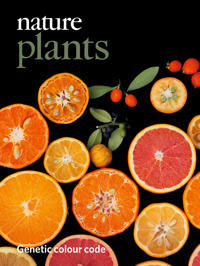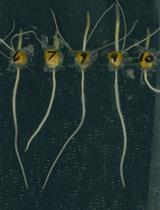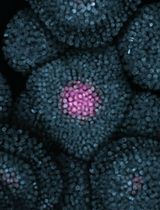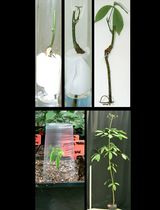- EN - English
- CN - 中文
Transient Expression Assay in Strawberry Fruits
草莓果实中的瞬时表达检测
发布: 2019年06月05日第9卷第11期 DOI: 10.21769/BioProtoc.3249 浏览次数: 8544
评审: Tie LiuPriyanka DasAnonymous reviewer(s)
Abstract
Strawberry, including the woodland strawberry Fragaria vesca (2x) and the cultivated strawberry (Fragaria × ananassa, 8x), has emerged as a model system for studying fruit development and ripening. Transient expression provides a quick assay for gene functions or gene interactions. In strawberry, virus-induced gene silencing (VIGS) and Agrobacterium tumefaciens-mediated transformation in fruit have been widely used as the transient expression approaches. Unlike VIGS, the latter one can be utilized not only for gene knock-down, but also for overexpression and knock-out. Here, we show the procedures of transiently expressing the 35S::FveMYB10 construct into fruit of the white-fruited F. vesca accession Yellow Wonder. As a master regulator of anthocyanin production, overexpressing FveMYB10 will cause fruit coloration, which was observed at one week post infiltration. We also exhibit the previous results of knocking down Reduced Anthocyanin in Petioles (RAP), encoding an anthocyanin transporter, by RNAi in fruit of the strawberry cultivar ‘Sweet Charlie’. Overall, Agrobacterium-mediated transient transformation in strawberry fruit is a quick and versatile approach for studying gene functions in fruit ripening.
Keywords: Transient expression (瞬时表达)Background
Cultivated strawberry (Fragaria × ananassa, 8x) is an economically important fruit crop grown worldwide with lovely appearance and rich nutrition. The wild diploid strawberry Fragaria vesca has emerged as a model plant for cultivated strawberry as well as other fleshy fruit species. Moreover, strawberry is a typical non-climacteric fruit, studies on the ripening of which lack a nice model system, like tomato as a model of the climacteric fruit. Therefore, strawberry is also frequently used for studying fruit ripening.
Stable transformation is doable in both woodland and cultivated strawberry; however, the entire process is labor-intensive and time-consuming. In contrast, the transient expression assay in fruit is much faster and more efficient. There are two transient gene expression approaches in strawberry, namely Virus-Induced Gene Silencing (VIGS) and Agrobacterium-mediated transformation (Spolaore et al., 2001). Some studies obtained nice results by using VIGS (Jia et al., 2011; Li et al., 2019). However, we utilize the Agrobacterium-mediated transformation more frequently as it can achieve more experimental aims, including gene knock-down (Hoffmann et al., 2006), overexpression (Huang et al., 2018), and knock-out (Tang et al., 2018).
The F. vesca fruit takes 25-30 days from being pollinated to ripen under our growth conditions. The entire process is divided into seven stages: flower/anthesis, small green, medium green, large green, white, turning, and red. Fruit receptacle (the juicy flesh) at the large green stage, when the firmness starts to decline rapidly (before the achenes turn red for the red strawberry fruit), is suitable for agrobacterium injection. Fruit receptacles at prior stages are recalcitrant to the injection owing to the texture. Thus, Agrobacterium-mediated transformation in strawberry fruit delimits functional studies on genes acting at late developmental stages.
The bright red color of strawberry fruit is caused by the accumulation of anthocyanin compounds, which is a visible phenotype to check. In strawberry, the R2R3-MYB transcription factor FveMYB10 is a master regulator of anthocyanin synthesis (Lin-Wang et al., 2014). The woodland strawberry includes both red-fruited and white-fruited varieties, owing to a natural SNP occurred in FveMYB10; overexpression of FveMYB10 results in accumulation of red pigments in fruit of the white-fruited accession Yellow wonder (YW) (Hawkins et al., 2016). Recently, we identified one anthocyanin transporter encoding gene Reduced Anthocyanin in Petioles (RAP) through chemical mutagenesis, knock-down of which greatly reduced fruit pigmentation (Luo et al., 2018).
In this study, as an example, we describe the procedures of transiently overexpressing FveMYB10 in fruit of YW. Moreover, we exhibit the results of knocking down RAP in fruit of the strawberry cultivar ‘Sweet Charlie’.
Materials and Reagents
- Tips
- Tag
- 1 ml syringe with needle (GEMTIER, catalog number: 0.45X16 RW LB)
- The white-fruited F. vesca accession Yellow Wonder (YW), and the strawberry cultivar ‘Sweet Charlie’
- Binary vectors: pK7WG2D for overexpression and pK7WIWG2D for RNAi. Both vectors contain a 35S::GFP cassette as a visual reporter
- Target genes: FveMYB10, FvH4_1g22020/gene31413; RAP, FvH4_1g27460/gene31672
- Yeast extract (OXOID, catalog number: LP0021)
- Tryptone (OXOID, catalog number: LP0042)
- Agar (TSINGKE, catalog number: 1182GR500)
- MS (PhytoTechnology Laboratories, catalog number: M404-50L)
- GV3101 Chemically Competent Cell (Shanghai Weidi Biotechnology, catalog number: AC1001)
- NaCl (HUSHI, catalog number: 10019318, CAS: 7647-14-5)
- Sucrose (HUSHI, catalog number: 10021418, CAS: 57-50-1)
- Antibiotics, including Kanamycin (Kan), Gentamicin (Gent), Rifampicin (Rif), and Spectinomycin (Spe) (Biofroxx, catalog numbers: 1162GR005, 1463GR001, R3501, and S8040, respectively)
- Luria Broth (LB) medium (see Recipes)
- Injection buffer (see Recipes)
- Antibiotics (see Recipes)
Equipment
- Incubator used for the growth of Agrobacterium at 28 °C (JINGHONG, catalog number: DNP-9022)
- Double temperature controlled thermostat (MIULAB, catalog number: BTH-100)
- Centrifuge (Eppendorf, 5424)
- Clean workbench (AIRTECH, SW-CJ-1FD)
- Full temperature shaker (Peiying, catalog number: THZ-C-1)
- Ultra-low temperature refrigerator (ThermoFisher SCIENTIFIC, Thermo ScientificTM FormaTM 88000)
- Fluorescence dissecting stereomicroscope (Leica, catalog number: M205FA)
- Plant growth room: 25 ± 3 °C, 16 h light/8 h dark, light intensity at 100 μmol m-2 sec-1
Procedure
文章信息
版权信息
© 2019 The Authors; exclusive licensee Bio-protocol LLC.
如何引用
Pi, M., Gao, Q. and Kang, C. (2019). Transient Expression Assay in Strawberry Fruits. Bio-protocol 9(11): e3249. DOI: 10.21769/BioProtoc.3249.
分类
植物科学 > 植物发育生物学 > 综合
分子生物学 > 蛋白质 > 活性
您对这篇实验方法有问题吗?
在此处发布您的问题,我们将邀请本文作者来回答。同时,我们会将您的问题发布到Bio-protocol Exchange,以便寻求社区成员的帮助。
Share
Bluesky
X
Copy link














